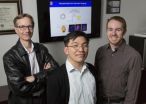(Press-News.org) CHAPEL HILL, N.C. (May 21, 2014) – Researchers at the UNC School of Medicine have found a new target for treating chronic pain: an enzyme called PIP5K1C. In a paper published today in the journal Neuron, a team of researchers led by Mark Zylka, PhD, Associate Professor of Cell Biology and Physiology, shows that PIP5K1C controls the activity of cellular receptors that signal pain.
By reducing the level of the enzyme, researchers showed that the levels of a crucial lipid called PIP2 in pain-sensing neurons is also lessened, thus decreasing pain.
They also found a compound that could dampen the activity of PIP5K1C. This compound, currently named UNC3230, could lead to a new kind of pain reliever for the more than 100 million people who suffer from chronic pain in the United States alone.
In particular, the researchers showed that the compound might be able to significantly reduce inflammatory pain, such as arthritis, as well as neuropathic pain – damage to nerve fibers. The latter is common in conditions such as shingles, back pain, or when bodily extremities become numb due to side effects of chemotherapy or diseases such as diabetes.
The creation of such bodily pain might seem simple, but at the cellular level it's quite complex. When we're injured, a diverse mixture of chemicals is released, and these chemicals cause pain by acting on an equally diverse group of receptors on the surface of pain-sensing neurons.
"A big problem in our field is that it is impractical to block each of these receptors with a mixture of drugs," said Zylka, the senior author of the Neuron article and member of the UNC Neuroscience Center. "So we looked for commonalities – things that each of these receptors need in order to send a signal." Zylka's team found that the lipid PIP2 (phosphatidylinositol 4,5-bisphosphate) was one of these commonalities.
"So the question became: how do we alter PIP2 levels in the neurons that sense pain?" Zylka said. "If we could lower the level of PIP2, we could get these receptors to signal less effectively. Then, in theory, we could reduce pain."
Many different kinases can generate PIP2 in the body. Brittany Wright, a graduate student in Zylka's lab, found that the PIP5K1C kinase was expressed at the highest level in sensory neurons compared to other related kinases. Then the researchers used a mouse model to show that PIP5K1C was responsible for generating at least half of all PIP2 in these neurons.
"That told us that a 50 percent reduction in the levels of PIP5K1C was sufficient to reduce PIP2 levels in the tissue we were interested in – where pain-sensing neurons are located" Zylka said. "That's what we wanted to do – block signaling at this first relay in the pain pathway."
Once Zylka and colleagues realized that they could reduce PIP2 in sensory neurons by targeting PIP5K1C, they teamed up with Stephen Frye, PhD, the Director of the Center for Integrative Chemical Biology and Drug Discovery at the UNC Eshelman School of Pharmacy.
They screened about 5,000 small molecules to identify compounds that might block PIP5K1C. There were a number of hits, but UNC3230 was the strongest. It turned out that Zylka, Frye, and their team members had come upon a drug candidate. They realized that the chemical structure of UNC3230 could be manipulated to potentially turn it into an even better inhibitor of PIP5K1C. Experiments to do so are now underway at UNC.
INFORMATION:
Funding for this study was provided by the National Institute of Neurological Disorders and Stroke.
Brittany Wright, PhD, graduated from the UNC Eshelman School of Pharmacy in 2014. She was the first author on the Neuron Paper. Along with Zylka and Frye, other authors include Jian Jin, PhD, Associate Director of the Center for Integrative Chemical Biology and Drug Discovery, and William Janzen, Director of Assay Development and Compound Profiling in the Center for Integrative Chemical Biology and Drug Discovery.
UNC researchers find new target for chronic pain treatment
The discovery could lead to new therapies for conditions such as arthritis, shingles, and back pain
2014-05-21
ELSE PRESS RELEASES FROM THIS DATE:
Cancer avatars for personalized medicine
2014-05-21
Researchers at University of California, San Diego School of Medicine and Moores Cancer Center have used computer simulations of cancer cells – cancer avatars – to identify drugs most likely to kill cancer cells isolated from patients' brain tumors.
The findings, published in May 21 online issue of the Journal of Translational Medicine, may help researchers stratify cancer patients for clinical trials according to their cancers' genomic signatures and predicted sensitivities to different cancer drugs.
Such an approach would allow scientists to selectively test cancer ...
Rhythmic bursts of electrical activity from cells in ear teach brain how to hear
2014-05-21
PITTSBURGH, May 21, 2014 – A precise rhythm of electrical impulses transmitted from cells in the inner ear coaches the brain how to hear, according to a new study led by researchers at the University of Pittsburgh School of Medicine. They report the first evidence of this developmental process today in the online version of Neuron.
The ear generates spontaneous electrical activity to trigger a response in the brain before hearing actually begins, said senior investigator Karl Kandler, Ph.D., professor of otolaryngology and neurobiology, Pitt School of Medicine. These patterned ...
NIH Pain Consortium's first pain care curriculum improves clinical skills
2014-05-21
An online training module designed for the evaluation and care of chronic pain greatly improved medical student clinical skills, according to a report in the Journal of the American Geriatrics Society. The module, built by the University of Pittsburgh and using an elderly woman with chronic lower back pain as a case study, is the first curriculum resource created through the efforts of the National Institutes of Health Pain Consortium's Centers of Excellence in Pain Education program (CoEPEs). The program was developed in response to the Affordable Care Act's mandate to ...
Illinois researchers combine weak chemical forces to strengthen novel imaging technology
2014-05-21
When University of Illinois Associate Professor of Chemical and Biomolecular Engineering Hyunjoon Kong, graduate student Cartney Smith, and colleagues set out to improve MR imaging (MRI), they turned current contrast agent technology on its head—or rather, they turned it inside out. The new compound they designed in collaboration with Illinois' Roger Adams Professor of Chemistry Steven C. Zimmerman is not only more effective, but also self-assembling. Kong is also a member of the Regenerative Biology and Tissue Engineering research theme at the Institute for Genomic Biology.
When ...
New study reveals corporate social responsibility can lead to better customer service
2014-05-21
Currently accepted wisdom in the corporate world is that in order to motivate frontline employees who serve customers, corporations need to increase their salary, make them feel more positive about the company, or give them more explicit instructions on how to interact with customers. A new study led by Drexel University's Daniel Korschun, PhD, an assistant professor at the LeBow College of Business, examines how frontline employees respond to corporate social responsibility (CSR) activities such as charitable giving, environmental programs and ethical practices. The study ...
New guidelines and technology needed for placement of feeding tubes in pediatric patients
2014-05-21
Universal guidelines and improvements in technology are needed to reduce injuries and deaths from improper placement of nasogastric feeding tubes in pediatric patients, according to a comprehensive review of published literature.
The review, conducted by the New Opportunities for Verification of Enteral Tube Location (NOVEL) Work Group Project of the American Society for Parenteral and Enteral Nutrition (A.S.P.E.N.) found that while the bedside placement of a nasogastric feeding tube is a common procedure conducted by nurses, incorrect placement can have serious and ...
New, fossil-fuel-free process makes biodiesel sustainable
2014-05-21
EAST LANSING, Mich. — A new fuel-cell concept, developed by an Michigan State University researcher, will allow biodiesel plants to eliminate the creation of hazardous wastes while removing their dependence on fossil fuel from their production process.
The platform, which uses microbes to glean ethanol from glycerol and has the added benefit of cleaning up the wastewater, will allow producers to reincorporate the ethanol and the water into the fuel-making process, said Gemma Reguera, MSU microbiologist and one of the co-authors.
"With a saturated glycerol market, traditional ...
Risky alcohol use in male-dominated industries
2014-05-21
New Rochelle, NY, May 21, 2014—The workplace can provide an ideal environment to implement support, well-being, and testing interventions aimed at reducing risky alcohol use among men. By targeting male-dominated industries, in particular, alcohol screening and prevention efforts may be effective in reducing alcohol use, according to a Review article in Journal of Men's Health, a peer-reviewed publication from Mary Ann Liebert, Inc., publishers. The article is available free on the Journal of Men's Health website.
A team of Australian researchers led by Nicole Lee, ...
Phase III clinical trial shows image fusion-guided biopsy significantly improves accuracy of prostate
2014-05-21
NEW HYDE PARK, NY – A recent study by investigators from LIJ Medical Center demonstrated that using magnetic resonance imaging (MRI) in men with an elevated prostate specific antigen (PSA) resulted in a prostate cancer detection rate that was twice as high as data reported in the March 1999 Prostate journal that analyzed men undergoing the standard 12-core biopsy with an elevated PSA. Physicians in the recent trial used a targeted approach to evaluate prostate cancer that combines MR imaging and transrectal ultrasound fusion guided prostate biopsy.
Given the limitations ...
Carnegie Mellon, Microsoft Research automate privacy compliance for big data systems
2014-05-21
PITTSBURGH—Web services companies, such as Facebook, Google and Microsoft, all make promises about how they will use personal information they gather. But ensuring that millions of lines of code in their systems operate in ways consistent with privacy promises is labor-intensive and difficult. A team from Carnegie Mellon University and Microsoft Research, however, has shown these compliance checks can be automated.
The researchers developed a prototype automated system that is now running on the data analytics pipeline of Bing, Microsoft's search engine. According to ...
LAST 30 PRESS RELEASES:
Drone sampling of whale breath reveals first evidence of potentially deadly virus in Arctic
Roman soldiers defending Hadrian’s Wall infected by parasites, study finds
Pinochet’s prisoners were tormented with music but still found solace in it, a new book reveals
Fertility remains high in rural Tanzania despite access to family planning
AI-assisted device can improve autism care access
Kinetic careers
Uncovering how parasitic plants avoid attacking themselves to improve crop resistance
Nanoparticle vaccine strategy could protect against Ebola and other deadly filoviruses
Study finds brain care score can predict risk of stroke across racial groups
Key lung immune cells can intensify allergic reactions
Do hormones explain why women experience more gut pain?
New materials conduct ions in solids as easily as in liquids
Breakthrough of the Year: Renewable energy begins to eclipse fossil fuel-based sources
LLM use is reshaping scientific enterprise by increasing output, reducing quality and more
Introducing LightGen, a chip for ultra-fast, ultra-efficient generative AI
Astronomers see fireworks from violent collisions around nearby star
ACC/AHA issue new guideline on managing congenital heart disease in adults
Cosmic crash caught on camera
Is talented youth nurtured the wrong way? New study shows: top performers develop differently than assumed
Ants: An untapped resource in the development of antibiotics?
Archaeologists use AI to create prehistoric video game
Mitochondria migrate toward the cell membrane in response to high glucose levels
Tiny viral switch offers hope against drug-resistant bacteria
Most parents aware of early peanut introduction guidelines, but confused about details
HPV vaccine can protect against severe lesions of the vulva and vagina
Virtual care provision and emergency department use among children and youth
Quadrivalent HPV vaccine and high-grade vulvovaginal lesions
Insights into dry eyes gained from stem cell-derived tear glands
Researchers identify 166 human pluripotent stem cell lines available for use in clinical applications
Europa Clipper instrument uniquely observed interstellar comet 3I/ATLAS
[Press-News.org] UNC researchers find new target for chronic pain treatmentThe discovery could lead to new therapies for conditions such as arthritis, shingles, and back pain





